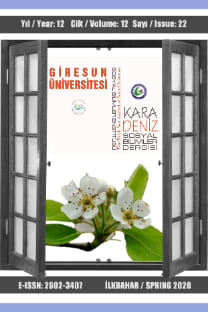Tarihsel Düşünme Becerileri İle Tarih Okuryazarlığı Becerilerinin Karşılaştırılması
Tarihsel düşünme becerileri, Tarih okuryazarlığı, Tarih öğretim programı
___
- Ahonen, S. (2005). Historical Consciousness: a Viable Paradigm For History Education? Curriculum Studies, 37(6), 697-707.
- Baykara, T. (2007). Tarih Araştırma ve Yazma Metodu. İstanbul: IQ Kültür Sanat Yayıncılık.
- Carr, E. H. (2011). Tarih Nedir. (çev. M. G. Gürtürk). İstanbul: İletişim Yayınları.
- Clark, A. (2006). Teaching the Nation. Melbourne: Melbourne University Press.
- Cooper, H. (2002). History in the Early Years. New York: Taylor & Francis Inc.
- Crawford, K., Ferguson, M., Kaufmann, G., Laird, J. (1994). Exploring Historical and Multicultural Perspectives Through Inquiry. In S. Steffey and W. J. Hood. (Eds.), If This Is Social Studies, Why Isn't It Boring? (pp.173-195). Portlaand: Stenhouse Paublishers.
- Dawson, I. (2007). Time For Chronology: Ideas For Developing Chronological Understanding. Teaching History, 117, 14-22.
- Demircioğlu, İ. H. (2006). Lise Öğrencilerinin Tarih Dersinin Amaçlarına Yönelik Görüşleri. TEBD, 4(2), 153-162.
- Dilek, D. (2007). Tarih Derslerinde Öğrenme ve Düşünce Gelişimi. Ankara: Nobel Yayınevi.
- Epstein. T. (2008). Interpreting National History: Race, Identity, and Pdagogy in Classrooms and Communities. New York: Routledge.
- Foster, S. (1999). Using Historical Empathy to Excite Students about the Study of History: Can You Empathize with Neville Chamberlain, The Social Studies, 90, 18-24.
- Grant, S. G. (2003). History Lesson: Teaching, Learning and Testing in USA High School Classrooms. Mahwah, New Jersey: LEA Puplishers.
- Jackson, K. T. ve Jackson, B. B. (1989). Why the Time is Rights to Reform the History Curriculum. In P. Gagnon. (Ed), Historical Literacy: The Case for History in American education, (pp.3-16). Boston: Houghton Mifin Company.
- Kabapınar, Y. (2009). Öğretmen Adaylarının Kronoloji Becerilerinin Saptanmasına Yönelik Bir Çalışma. IV. Sosyal Bilimler Eğitimi Kongresi, (7-9 Ekim), İstanbul, Marmara Üniversitesi.
- Karabağ, Ş. G. (2010). Tarihsel Empati Becerisi: Öğretimi, Ölçülmesi Ve Değerlendirilmesi., M. Safran. (Editör). Tarih Nasıl Öğretilir? Tarih öğretmenleri için Özel Öğretim Yöntemleri. İstanbul. Yeni İnsan Yayınevi, ss. 116-123.
- Karabulut, F. (2005). Dil Ölümü Bağlamında Uygur Türk Toplumu. Bilig, 35, 17-47.
- Levstik, L. ve K. C. Barton, (2005). Doing History: Investigating with Children in Elementary and Middle Schools. Mahwah, New Jersey: LEA Puplishers.
- Özdemir, Ç. (1995). Sosyal Bilgiler Öğretiminde İnsan İlişkilerinin Yeri ve Önemi. TED XIII. Öğretim Toplantısı: Sosyal Bilgiler Öğretimi ve Sorunları Sempozyumu (25-26 Mayıs), Ankara, TÜBİTAK
- Parkes, R. ve Donnelly, D. (2014). Changing Conceptions of Historical Thinking in History Education: an Australian Case Study. Tempo & Argumento, 6(11), online: http://revistas.udesc.br/index.php/tempo/article/view/2175180306112014113/3058.
- Ravitch, D. (1989). The Plight of History in American Schools. In P. Gagnon. (Ed), Historical Literacy: The Case for History in American education, (pp.51-69). Boston: Houghton Mifin Company.
- Reed, E. W. (1989). For Better Elementary Teaching: Methods Old and New. In P. Gagnon. (Ed), Historical Literacy: The Case for History in American education, (pp.302-321). Boston: Houghton Mifin Company.
- Safran, M. (2010). Tarih Nerededir? M. Safran. (Ed), Tarih Nasıl Öğretilir? Tarih öğretmenleri için Özel Öğretim Yöntemleri. İstanbul. Yeni İnsan Yayınevi, ss. 19-22.
- Seixas, P. (2006). What is Historical Consciousness? In R. Sandwell. (Ed), History Education, Public Memory & Citizenship in Canada, (pp.11-22). Toronto: University of Toronto Press.
- Stearns, P. N. (1991). The Challenge of “Historical Literacy.” Perspectives: American Historical Association Newsletter, 29, 21-23.
- Sunal C. S. ve Haas, M. E. (2005). Social Studies for the Elementary and Middle Grades. A Constructivist Approach. Boston: Pearson Education Company.
- Şimşek, A. (2006). İlköğretim Öğrencilerinde Tarihsel Zaman Kavraminin Gelişimi ve Öğretimi. Yayımlanmamış Doktora Tezi, Gazi Üniversitesi Eğitim Bilimleri Enstitüsü, Ankara.
- Şimşek, A. (2012). Ilköğretim Öğrencilerinde Tarihsel Zaman ve Kronoloji Becerileri. M. Safran. (Edr), Sosyal Bilgiler Öğretimi, Ankara. Pegem Akademi, ss. 93-117.
- Taylor, T. ve Young, C. (2003). Making History: A Guide for the Teaching and Learning of History in Australian School. Carlton South: Curriculum Corporation.
- Tekeli, İ. (1998). Tarih Bilinci ve Gençlik. İstanbul: Tarih Vakfı Yurt Yayınları.
- Turner-Bisset, R. (2005). Creative Teaching: History in the Primary Classroom. London: David Fulton Publishers.
- Walsh, H. W. (1971). An Introduction to the Philosophy of History. London: Hutchinson.
- Wertz, S. K. (1996). Moral Judgments in History: Hume's Position. Hume Studies, 22(2), 339- 367.
- ISSN: 2602-3407
- Yayın Aralığı: Yılda 2 Sayı
- Başlangıç: 2009
- Yayıncı: -
Eğitime Adanmış Bir Ömür: Efsane Öğretmen Tekışık
Görsel Sanatlar Öğretmenlerinin Kullandıkları Öğretim Teknolojileri ve Materyalleri
Elif MAMUR YILMAZ, Sema BİLİCİ
Farklı Denetim Odağına Sahip Öğrencilerin Okul Bağlılık Düzeylerinin İncelenmesi
Neslin İHTİYAROĞLU, Esra DEMİR
Didem TÜRKOĞLU, Gülümser GÜLTEKİN AKDUMAN
Tarihsel Düşünme Becerileri İle Tarih Okuryazarlığı Becerilerinin Karşılaştırılması
Namık Tanfer ALTAŞ, Yavuz DEĞİRMENCİ
Kadın Okul Yöneticilerinin Durumluk Ve Sürekli Kaygı Düzeyleri
Nezahat GÜÇLÜ, Öznur TULUNAY ATEŞ, Neslin İHTİYAROĞLU
Yurt Dışında Türkçe Dersi Gören Öğrencilerin Derse ilişkin Memnuniyet Düzeyleri
Erdal ÖZCAN, Gökmen BOZTİLKİ, Bekir İNCE
İlköğretim Öğretmen Adaylarının Kariyer Planları ve Öğretmenlik Mesleğine Yönelik Tutumları
